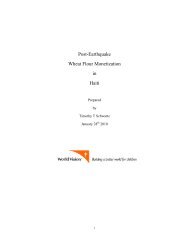Post Earthquake Jacmel (Haiti) Report and EMMA
Create successful ePaper yourself
Turn your PDF publications into a flip-book with our unique Google optimized e-Paper software.
10<br />
were not impacted directly by the earthquake. The UN, whose various organizations operate<br />
much like NGOs (for example the World Food Program that took over CARE International‘s<br />
Northwest <strong>and</strong> Artibonite activity zones) reportedly gave all local employees US$2,500. Other<br />
activities to be discussed shortly are increased motorcycle taxi traffic <strong>and</strong> increased sales of<br />
phone cards. In effect, for many, the earthquake has been a boon.<br />
In summary, NGOs have tried in recent years to fulfill many of the functions that should<br />
have been, but were not, filled by the <strong>Haiti</strong>an State. But this is not sufficient to have completely<br />
offset economic crisis; nor to change more than 200 years of adaptation. As will be seen below,<br />
the absence of State <strong>and</strong> any effective social security system, has meant that people must assure<br />
this social security themselves. For the rural areas, the need to maintain a degree of selfsufficiency<br />
in the face of impending crop failure, pestilence, <strong>and</strong> uncertain market opportunities<br />
means that most people living there have no choice but to devote much of their time <strong>and</strong><br />
resources to a type of subsistence oriented livelihood. This does not mean that people in the<br />
Southeast are subsistence producers for as will be seen shortly, the market plays a major role in<br />
the regional economy. But the strategies are definitively subsistence oriented <strong>and</strong> they have not<br />
only served the peasants well during past crises, they have served the entire country well, for it is<br />
the rural semi-subsistence survival strategies <strong>and</strong> regional marketing systems that have assured<br />
survival through the dozens of hurricanes <strong>and</strong> political <strong>and</strong> military crises that have afflicted the<br />
region for over three-hundred years. For this reason, the other income strategies <strong>and</strong> urban<br />
livelihood strategies will be discussed in greater detail later in the report for in general they<br />
represent the incursion of a different economy <strong>and</strong> a different system, one that is not as<br />
entrenched in most of <strong>Haiti</strong> <strong>and</strong> certainly not historically as dependable, a fact that leads to<br />
misunderst<strong>and</strong>ings <strong>and</strong> frustrations among aid workers who tend to arrive in the country with the<br />
impression that <strong>Haiti</strong>ans depend more on the World economy than on the traditional farming<br />
strategies <strong>and</strong> the country‘s own internal marketing system.<br />
3. Principal Regional Livelihood Strategies<br />
3.1. Farming, Fishing, <strong>and</strong> Charcoal<br />
The principal income-generating <strong>and</strong> subsistence activities in the area are agriculture<br />
(including tree crops), livestock raising, petty commerce, charcoal production, <strong>and</strong> fishing. The<br />
tools <strong>and</strong> strategies used in these endeavors are no more complex than picks, hoes, machetes,<br />
rowboats, bamboo fishing traps, <strong>and</strong> string nets. People in the region do not use cows or horse<br />
traction to plow fields—as they do in <strong>Haiti</strong>‘s Central Plateau. There are few pumps; farmers with<br />
gardens plots near to springs <strong>and</strong> rivers sometimes manually haul buckets of water to irrigate<br />
crops, particularly vegetables in cool highl<strong>and</strong> areas; 2% of arable l<strong>and</strong> is canal irrigated. Only<br />
one in ten (or fewer) fishing boats are equipped with motors. The use of chemical or processed<br />
fertilizers <strong>and</strong> pesticides is almost entirely confined to highl<strong>and</strong> vegetable gardens <strong>and</strong>, to a<br />
lesser degree, beans (also considered a cash crop), that dependably yield profits.<br />
While not all farmers engage in the commercial-oriented agriculture mentioned above,<br />
virtually all rural households have members engaged in the cultivation of semi-subsistence<br />
gardens <strong>and</strong> livestock rearing. Semi-subsistence gardens are part of a household safety net, <strong>and</strong><br />
are adapted principally to minimizing risk in the face of drought, hurricane, <strong>and</strong> unpredictable
















